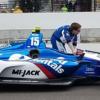A nice video of a 5.7 litre two valve per cylinder pushrod small block Chevy running up to 11,000 rpm.
https://www.enginela...-rpm-dyno-pull/
The builder admits that peak power is down at 9,000 rpm but it can reach 11K under its own power.
Maybe we should put videos like this a soundtrack archive to remember the noise when all cars, road or racing, are electric!














